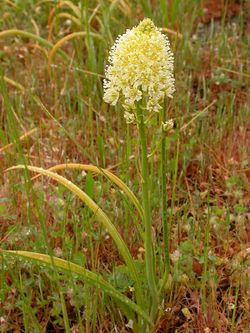Difference between revisions of "Toxicoscordion venenosum"
m (→Photo Gallery) (Tag: VisualEditor) |
m (Tag: VisualEditor) |
||
| Line 1: | Line 1: | ||
| − | Toxicoscordion venenosum var. venenosum | + | * Scientific Name: ''Toxicoscordion venenosum var. venenosum'' |
| + | * Family: Melanthiaceae | ||
| + | * Common Names: death camas, meadow death camas, common death camas, deadly zigadenus. | ||
| + | * Synonyms and Misapplications: ''Zigadenus venenosus'' | ||
| + | * Codon: TOXVEN | ||
[[File:TOXSCO1.jpg|thumb|333x333px|Toxicoscordion venenosum. Photo Ben Legler 2004]] | [[File:TOXSCO1.jpg|thumb|333x333px|Toxicoscordion venenosum. Photo Ben Legler 2004]] | ||
| Line 31: | Line 35: | ||
==Distribution== | ==Distribution== | ||
| − | British Columbia to Baja California, east to the Dakotas; var. venenosum more common west of the Cascades in Washington, var. graminaeum common in Eastern WA.<ref name=":0">Hitchcock, C. | + | British Columbia to Baja California, east to the Dakotas; var. venenosum more common west of the Cascades in Washington, var. graminaeum common in Eastern WA.<ref name=":0">Hitchcock, C. L., Cronquist, A., Giblin, D., |
| − | + | & Legler, B. et al. (2018). ''Flora of the Pacific Northwest: an | |
| − | + | illustrated manual''. Seattle: University of Washington Press</ref> | |
==Habitat== | ==Habitat== | ||
Coastal bluffs and prairies, grassy hillsides, and moister areas of shrub-steppe and open pine woodlands<ref name=":0" /> | Coastal bluffs and prairies, grassy hillsides, and moister areas of shrub-steppe and open pine woodlands<ref name=":0" /> | ||
Revision as of 15:24, 21 April 2020
- Scientific Name: Toxicoscordion venenosum var. venenosum
- Family: Melanthiaceae
- Common Names: death camas, meadow death camas, common death camas, deadly zigadenus.
- Synonyms and Misapplications: Zigadenus venenosus
- Codon: TOXVEN
Contents
Taxonomy
| Toxicoscordion venenosum | |
|---|---|
| Scientific classification | |
| Kingdom: | Plantae |
| Subkingdom: | Tracheobionta |
| Phylum: | Spermatophyta |
| Subphylum: | Magnoliophyta |
| Class: | Liliopsida |
| Subclass: | Lilidae |
| Order: | Liales |
| Family: | Melanthiaceae |
| Genus: | Toxicoscordion V. |
| Species: | Toxicoscordion venenosum Rydb. |
| Synonyms | |
|
Zigadenus venenosus | |
Description
General: Glabrous perennial herb from an onion-like bulb, the simple stem 2-5 dm. tall. Leaves: Leaves mostly basal, linear, keeled, 1-3 dm. long and 3-6 mm. broad; cauline leaves strongly reduced upward. Flowers: Inflorescence a raceme (but sometimes the raceme branched at the base) up to 1.5 dm. long, the flowers all perfect; perianth white to cream-colored, bell-shaped; tepals 6, slightly unequal, the outer 4.5-5 mm. long, short-clawed, the inner about 0.5 mm. longer with a narrower, slightly longer claw; the gland at the base of each tepal yellowish-green, broader than long; stamens 6, about equal to the tepals; styles 3, distinct, 2-3 mm. long. Fruit: Capsule 8-15 mm. long.
Bloom Period
April-July
Distribution
British Columbia to Baja California, east to the Dakotas; var. venenosum more common west of the Cascades in Washington, var. graminaeum common in Eastern WA.[1]
Habitat
Coastal bluffs and prairies, grassy hillsides, and moister areas of shrub-steppe and open pine woodlands[1]
Uses
Medicinal Uses
Traditionally used as a violent emetic, sometimes mixed with blue flag; poultice of mashed roots applied to rheumatism, boils, bruises, sprains, sore legs, burns, swellings, rattlesnake bites, and broken bones to speed healing; mashed roots sometimes used as an arrow poison.[2]




